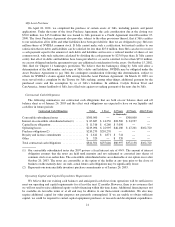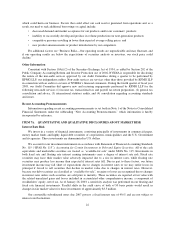NVIDIA 2003 Annual Report Download - page 27
Download and view the complete annual report
Please find page 27 of the 2003 NVIDIA annual report below. You can navigate through the pages in the report by either clicking on the pages listed below, or by using the keyword search tool below to find specific information within the annual report.• the ability of IBM, TSMC and any additional third-party manufacturers to effectively manufacture our
new products in a timely manner;
• the quality of any new products;
• differentiation of new products from those of our competitors;
• market acceptance of our products and our customers’ products; and
• availability of adequate quantity and configurations of various types of memory products.
Our strategy is to utilize the most advanced semiconductor process technology appropriate for our products
and available from commercial third-party foundries. Use of advanced processes has in the past resulted in initial
yield problems. New products that we introduce may not incorporate the features and functionality demanded by
PC OEMs, add-in board and motherboard manufacturers and consumers of 3D graphics. In addition, we may not
successfully develop or introduce new products in sufficient volumes within the appropriate time to meet both
the PC OEMs’ design cycles and market demand. We have in the past experienced delays in the development of
some new products. Our failure to successfully develop, introduce or achieve market acceptance for new
3D graphics products would harm our business. In particular, we experienced delays in the introduction of
graphics processors using our next generation technology during the second half of fiscal 2003 and any such
delays in the future or failure of these or other processors to meet or exceed specifications of competitive
products could materially harm our business.
Our failure to identify new product opportunities or develop new products could harm our business.
As our 3D graphics processors develop and competition increases, we anticipate that product life cycles at
the high end will remain short and average selling prices will continue to decline. In particular, we expect
average selling prices and gross margins for our 3D graphics processors to decline as each product matures and
as unit volume increases. As a result, we will need to introduce new products and enhancements to existing
products to maintain overall average selling prices and gross margins. In order for our 3D graphics processors to
achieve high volumes, leading PC OEMs and add-in board and motherboard manufacturers must select our 3D
graphics processor for design into their products, and then successfully complete the designs of their products
and sell them. We may be unable to successfully identify new product opportunities or to develop and bring to
market in a timely fashion new products. In addition, we cannot guarantee that new products we develop will be
selected for design into PC OEMs’ and add-in board and motherboard manufacturers’ products, that any new
designs will be successfully completed or that any new products will be sold. As the complexity of our products
and the manufacturing process for products increases, there is an increasing risk that we will experience
problems with the performance of products and that there will be delays in the development, introduction or
volume shipment of our products. We may experience difficulties related to the production of current or future
products or other factors may delay the introduction or volume sale of new products we developed. In addition,
we may be unable to successfully manage the production transition risks with respect to future products. Failure
to achieve any of the foregoing with respect to future products or product enhancements could result in rapidly
declining average selling prices, reduced margins and reduced demand for products or loss of market share. In
addition, technologies developed by others may render our 3D graphics products non-competitive or obsolete or
result in our holding excess inventory, any of which would harm our business.
We could suffer a loss of market share if our products contain significant defects.
Products as complex as those offered by us may contain defects or failures when introduced or when new
versions or enhancements to existing products are released. We have in the past discovered defects and
incompatibilities with customers’ hardware in certain of our products and may experience delays or loss of
revenue to correct any new defects in the future. Errors in new products or releases after commencement of
commercial shipments could result in loss of market share or failure to achieve market acceptance. Our products
typically go through only one verification cycle prior to beginning volume production and distribution. As a
result, our products may contain defects or flaws that are undetected prior to volume production and distribution.
25
























